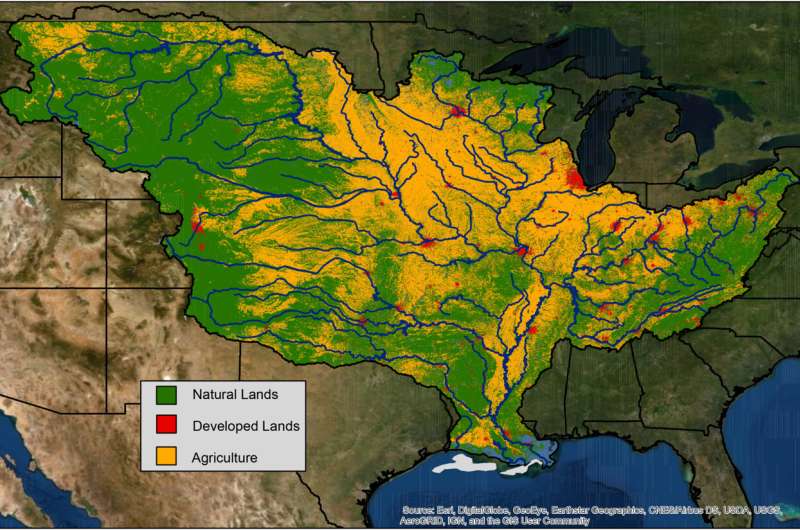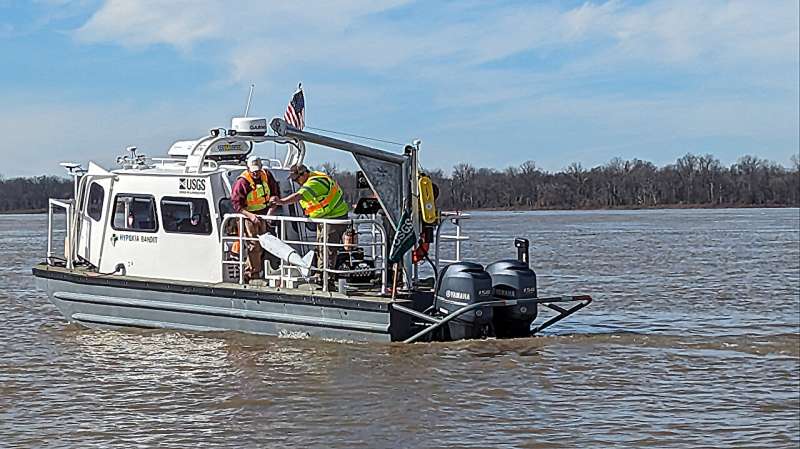This article has been reviewed according to Science X's editorial process and policies. Editors have highlighted the following attributes while ensuring the content's credibility:
fact-checked
trusted source
proofread
NOAA forecasts above-average summer 'dead zone' in Gulf of Mexico

NOAA is forecasting an above-average summer "dead zone" in the Gulf of Mexico covering approximately 5,827 square miles—an area roughly the size of Connecticut. The dead zone, or hypoxic area, is an area of low oxygen that can kill fish and other marine life. It occurs every summer and is primarily a result of excess nutrient pollution from human activities in cities and farm areas throughout the Mississippi-Atchafalaya watershed. The average dead zone measurement is 5,205 square miles over the 37-year period of record.
The U.S. Geological Survey (USGS) provides Mississippi and Atchafalaya river discharge and nutrient loading data for the month of May, which are key factors used by NOAA forecast models to estimate the size of the Gulf's dead zone during the summer. In May 2024, discharge in the Mississippi and Atchafalaya rivers was about 5% above the long-term average between 1980 and 2023, and the nitrate and phosphorus loads were about 7% below and 22% above the long-term averages, respectively.
"Reducing the impact of hypoxic events and lessening the occurrence and intensity of future dead zones continues to be a NOAA priority," said National Ocean Service Assistant Administrator Nicole LeBoeuf. "These forecasts are designed to provide crucial data to scientists, coastal managers and communities, and are used as guideposts in the development of planning actions."
When excess nutrients reach the Gulf of Mexico via the Mississippi-Atchafalaya River Basin, they stimulate an overgrowth of algae. When these algae die and decompose, they deplete oxygen in the water as they sink to the bottom. The resulting low oxygen levels cause motile animals, like fish and shrimp, to leave the area. Exposure to hypoxic waters has been found to alter fish diets, growth rates, reproduction, habitat use and the availability of commercially harvested species like shrimp.

This is the seventh year NOAA has produced a dead zone forecast using a suite of models jointly developed by the agency and its partners—teams of researchers at the University of Michigan, Louisiana State University, William & Mary's Virginia Institute of Marine Science, North Carolina State University and Dalhousie University. NOAA integrates the results of these models into an aggregate "ensemble" model forecast.
USGS measures river discharge and nutrient levels using about 3,000 real-time streamgages, 73 real-time nitrate sensors and 37 long-term monitoring sites in rivers throughout the Mississippi-Atchafalaya watershed. These data are used to track long-term changes in nutrient inputs to the Gulf and to build models of nutrient sources and hotspots within the watershed.
"USGS has monitored streams and groundwater in the Mississippi-Atchafalaya watershed for decades to help better understand the sources and impacts of water quality problems," said Joshua Joseph, acting USGS associate director for Water Resources. "A recent USGS study found that in the Illinois River—a major tributary of the Mississippi River—algae initially grow in the upper river and are then transported downstream, potentially causing algal toxins and decreased dissolved oxygen in the lower river."
This annual forecast is a key metric that informs the collective efforts of the Interagency Mississippi River and Gulf of Mexico Hypoxia Task Force, which has set a long-term goal of reducing the dead zone to 1,900 square miles by 2035. NOAA's hypoxia forecast models and USGS monitoring of nutrients and water discharge in rivers help to predict how hypoxia in the Gulf of Mexico is linked to nutrients coming from throughout the Mississippi-Atchafalaya watershed. The Task Force in turn uses this information to inform nutrient reduction targets across the Mississippi watershed states.
To confirm the size of the hypoxic zone and refine the forecast models, a NOAA-supported monitoring survey is conducted each summer, with results released in early August. NOAA and its partners continue to develop additional hypoxia forecasting capabilities, tools and models to understand impacts on living marine resources under various nutrient reduction actions.
Provided by NOAA Headquarters




















